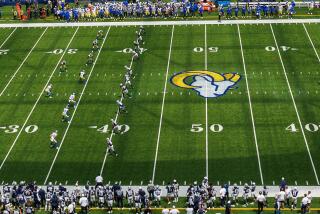NCAA Approves Three-Point Play, Instant Replay; Coaches Perplexed
- Share via
DALLAS — The three-point goal and use of televised instant replays to correct timing and scoring errors will become part of college basketball starting next season, the NCAA men’s rules committee announced Wednesday.
Under another rule change, coaches no longer will be charged with a technical foul if they leave the coaching box to protest errors involving timing, scoring or alternating possession.
Dr. Edward S. Steitz, secretary-editor of the rules committee, said the three-point goal, which has become a popular feature in the NBA, was adopted by the 12-member committee following five years of experimentation among 20 conferences.
Three points will be credited for a shot made 19 feet 9 inches or more from the basket.
Reacting to the rule changes, coaches and assistants appeared surprised and even disappointed over the adoption of the three-point play, but they generally favored using TV replays to assist in certain circumstances.
“I’m very surprised to see it (the three-point goal) pass,” Notre Dame Coach Digger Phelps said. “I didn’t realize it was under serious consideration, based on the experimentation by major conferences a few years back, which generally seemed to be negative.
“It would be nice, one of these years, to let the game settle down and see what we really have. If anything needed to be addressed, it’s still the foul situation at the end of games.”
That feeling was echoed by Wyoming Coach Jim Brandenburg.
“We just got the 45-second clock. We should stabilize the game,” Brandenburg said. “I’m not terribly upset, but I don’t like the change. We should get settled in some more before we get more changes.”
Louisville assistant coach Jerry Jones, who said he was speaking for Coach Denny Crum, said his first reaction to the three-point goal was “that shot can cause as much harm as benefit because it’s not a high-percentage shot.
“I think it’s a way of legislating against zone defenses without really saying so,” Jones said.
“We put the (shot) clock in and if that didn’t keep you out of the zone, we’ll put the three-point play in to make you play man-to-man,” Jones said the NCAA seemed to be saying.
The use of TV replay, however, is a positive move, Jones said.
“If they cannot correct an error by normal channels--that is by statistics or play-by-play--there’s nothing wrong with using a replay to correct something like a clock error,” he said. “Anytime you can eliminate an error, that is something positive.”
Steitz emphasized that instant replays will be used only to correct mistakes made by scorers and timers, and not for any officiating calls.
Jacksonville Coach Bob Wenzel said he is totally against the three-point goal “from any distance. We’ve experimented with it in the Sun Belt Conference a few years back, and we didn’t like it. I don’t think many coaches do,” he said.
“I think perhaps we’re fooling around with the rules too much.”
Steitz, athletic director at Springfield, Mass., College, said it is hoped the three-pointer will ease the rough play underneath the basket and give more attention to outside play.
“It’s going to force teams to play more defense away from the basket,” he said. “People will say, ‘You are putting the little man back in the game,’ and that’s good.”
Steitz said conferences experimented with different distances for the three-point goal before adopting the 19-9 distance.
“Some conferences used the pro distance (23-9) and didn’t find that desirable,” he said. “As a result of a questionnaire, most of the coaches preferred 19-9.”
In another rules changes, the committee eliminated the 28-foot hash marks and the combination count while a player is being closely guarded in the midcourt area.
Under the new rule, the entire front court will have a five-second count on a closely guarded player for either holding or dribbling the ball.
“Having just one count eliminates a lot of confusion,” Steitz said.
Steitz said the committee also singled out several existing rules that would be stressed next season.
They include illegal use of hands and arms during rough post play; ejection of players because of flagrant intentional fouls; illegal screening away from the ball, and three-second violations.
The committee also listed several items for experimentation, including:
--Creation of a rear boundary arc concept. Instead of requiring 10 seconds to cross midcourt, teams would have to advance to the arc within 10 seconds.
--Widening the free-throw lanes to the NBA width of 16 feet.
--Reducing the size of the backboard as a safety factor. The size reduction would be below the basket to help prevent player injury.
--Permit a player with four personal fouls at the end of regulation play to receive two more fouls in overtime play before fouling out. A player who fouled out in regulation play could not return in overtime.
--Reduce officials’ pregame jurisdiction from 30 minutes to 20 minutes.
More to Read
Go beyond the scoreboard
Get the latest on L.A.'s teams in the daily Sports Report newsletter.
You may occasionally receive promotional content from the Los Angeles Times.










